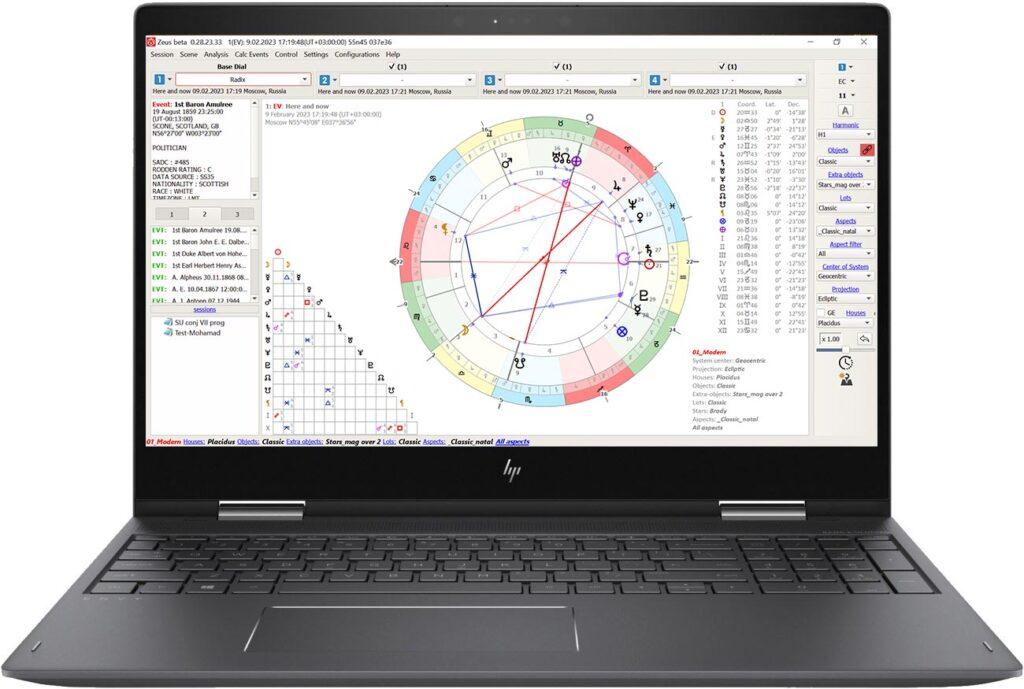
ASTRONOMICAL FUNCTIONS
COORDINATE SYSTEMS
CENTER OF THE SYSTEM
- Geocentric
- Topocentric
- Heliocentric
- Hybrid (objects calculated in the geocentric system are displayed on the chart, and duplicates of objects calculated in the heliocentric system are created)
PROJECTION PLANE
- Ecliptic
- Equator
- Declination
- Horizon (choice of astrological or geodetic azimuths)
- Prime Vertical
- Meridian
- Mundane Projection
CALCULATIONS
- Object calculations (see below) are done using licensed Swiss Ephemeris
- 34 systems of astrological houses, and an unlimited number of houses by Principe, including sensitive points, thematic houses, and geodetic equivalents by Sepharial and Grimm-Friedrich, with reverse calculation capability
- Calculation of solar and lunar eclipses with circumstances of the eclipses. Eclipses can be displayed in tabular form, on a regular chart, and on a geographic chart
- Calculation of planetary orbital parameters
- Tools for comprehensive analysis of symmetrical patterns are implemented
- Objects calculated according to four different data sets can be displayed on the scene simultaneously, corresponding to each of the main dials. Separate display of charts for each dial is also possible, i.e., not as a single dial with spheres, but as separate charts placed next to each other. Calculation tables can be displayed alongside the dials
- An unlimited number of independent charts based on these data can be displayed in addition to the general chart with a maximum of 5 dials (4 main + extra dial)
OBJECTS
Objects used in the program:
- Real planets (from the Sun to Pluto)
- Hypothetical planets of the Hamburg School + Proserpina
- Midpoints
- Stars
- Lots (in addition to built-in ones, user-created)
- Part of Fortune according to Placidus (considering latitude)
- Asteroids (support for over 22,000 named asteroids)
- Lunations
- Eclipses
- Mutations
- Antiscia and contra-antiscia
- Natal arc parts (more details in W. Lilly’s “Christian Astrology”)
- Zodiacal divisions
- Apsides and planetary nodes
CELESTIAL SPHERE

Visualization of calculated data can be performed not only in the form of 2D charts but also in the form of a 3D sphere with many settings. The sphere can also display objects, including stars, the grid of the selected coordinate system, main points and axes of coordinate systems, and the grid of houses.
So far, the Sphere is implemented only for Windows.
ASTRO-CALCULATOR
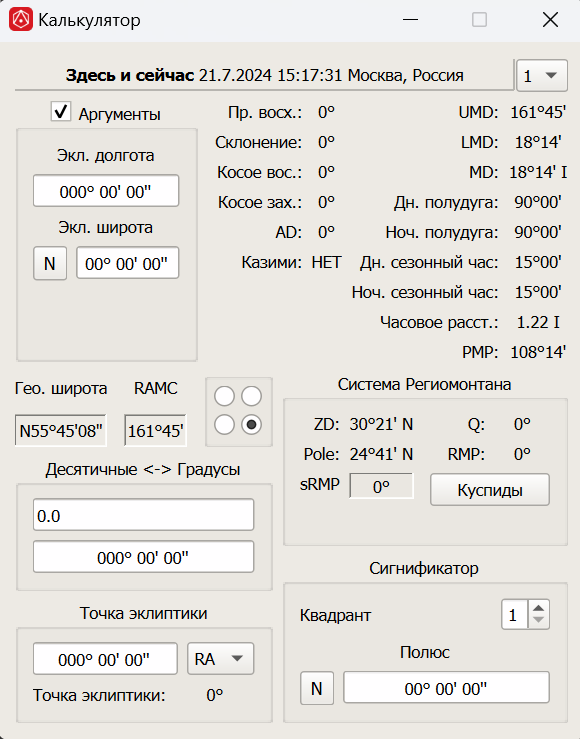
The Astro-calculator is designed for various astronomical and astrological calculations related to coordinate systems. In addition to converting from one coordinate system to another, for a given point, it can calculate:
- Quadrant of object’s location
- Oblique ascension and setting
- Difference in ascensions
- Upper and lower meridian distance
- Day and night semi-arc
- Day and night seasonal hour
- Hourly distance
- Mundane position in Placidus and Regiomontanus systems
- Determination of Cazimi
- Zenith distance
- Pole
- Difference in ascensions at the own pole
- Oblique ascension/setting at the own pole
- Oblique ascension/setting at the pole of the significator
- Table of house dials by Regiomontanus
ASTROLOGICAL FUNCTIONS
ZODIAC
- Tropical
- Sidereal (35 ayanamsas)
- Arbitrary (in addition to the draconic, planetary zodiacs can be used)
HARMONICS
Selection of any harmonic from 1 to 2000.
ANALYTICAL CALCULATIONS
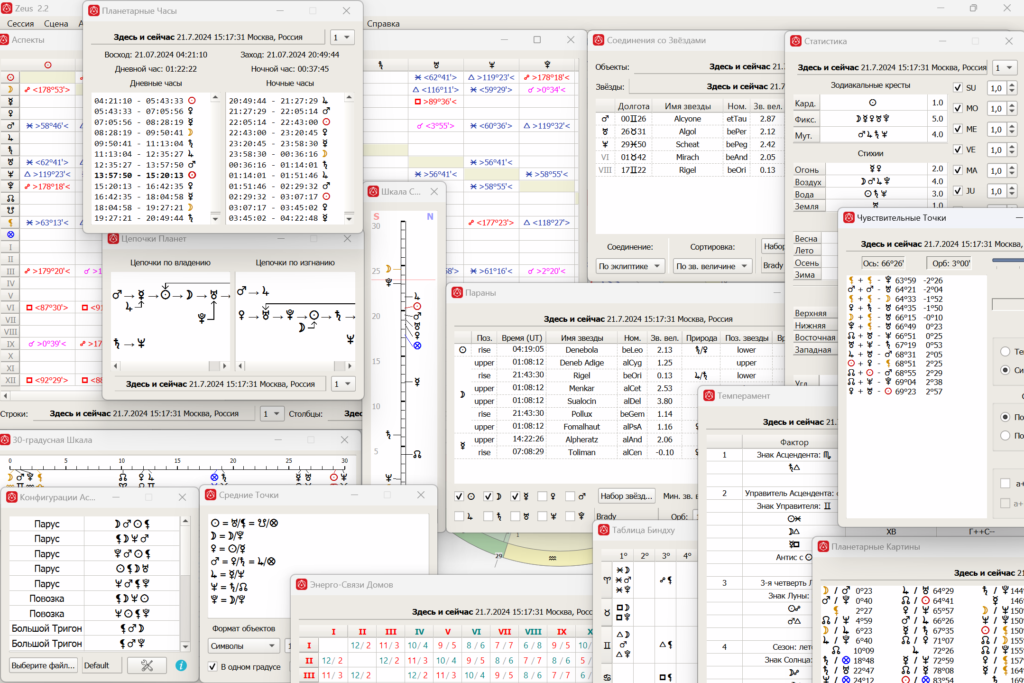
- Aspect table
- 30-degree scale
- Conjunctions with stars
- Conjunctions with asteroids
- Declination scale
- Parans
- Planet chains
- Bindhu table
- Statistics
- Synastric matrices (used in harmonic astrology)
- Aspect configurations (with interactive link to the chart)
- Midpoints
- Energy connections of houses
- Aspect chains
- Coordinates (list of coordinates of objects with various astronomical and astrological parameters)
- Antiscia
- Zodiacal divisions (duads, novenaries, dodecatemories)
- Table of dignities
- Essential dignities
- Accidental dignities
- Almutenes
- Thematic almutenes
- Planetary sects
- Ruler of Geniture (according to Lilly)
- Ruler of Geniture (according to Ben Ezra)
- Hyleg (according to Schöner)
- Temperament
- Planetary hours
- Firdar (according to Al-Biruni and Bonatti)
- Aphasis
- Decennials
- Chronocrators by terms
- Chronocrators by profections
- Planets in houses
- Planetary pictures
- Sensitive points
- Arc resonances
EVENT CALCULATIONS
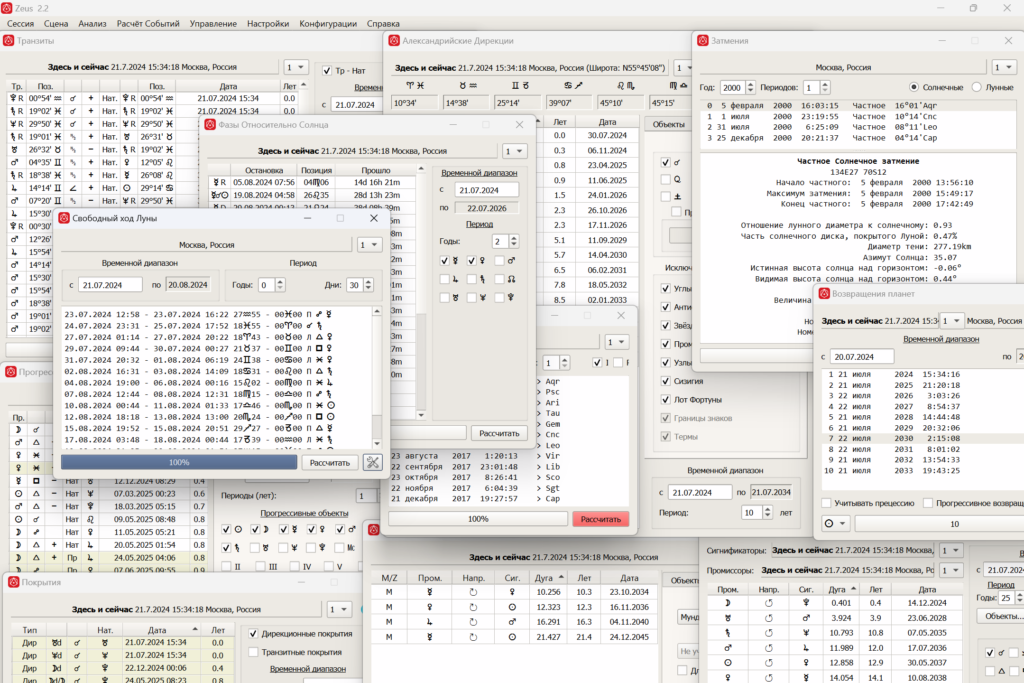
- Sequence of events (list of various events such as aspects, ingresses, phase changes, crossings of the equator and ecliptic that occurred and will occur from the specified date. Relevant for horary astrology)
- Transits
- Progressions
- Coverings
- Directions
- Primary directions
- Alexandrian directions
- Profections
- Returns (planetary returns can be calculated, considering precession, progressive return, and selecting the return aspect)
- Eclipses
- Ingresses and phases
- Phases relative to the Sun
- Heliacal phases
- Risings, settings, and culminations
- Lunations
- Lunar days
- Void of course Moon
CHARTS, CALENDARS, AND DIAGRAMS

- Calendar (various events for each day of the month: Moon phase, void of course Moon period, planetary stations, aspects, ingresses into signs)
- Aspect graphs (graphs of aspects between objects for a selected time period. In addition to aspects, visualization of declination parallels, latitude, and retrograde loops is possible)
- Graphic ephemerides
- Graph of the dynamics of the selected aspect (parallels, antiscia) over time
ASTROLOGICAL CHARTS
- Radix
- Transit
- Progressions (direct and reverse, various variations with 4 algorithms for calculating cusps)
- Directions (zodiacal, equatorial, primary, planetary arc, fixed arc, direct, reverse, with the possibility to direct not only the base chart but also the solar return with lunar return, which will be calculated automatically. Cusps can be calculated from MC)
- Profections (settings similar to directions)
- Return charts (solar, lunar, mercurial, etc.)
- Monthly solar return
- Daily solar return
- Annual horoscope (Sun ingress into 0 Capricorn)
- Solar eclipse
- Lunar eclipse
- Previous syzygy
- Minor lunation – chart of the nearest preceding event when the angular distance between the Sun and Moon is a multiple of 11.25 degrees
- Mundane solar return of the Meridian – first the annual horoscope is calculated, then the subsequent event when the transiting Sun conjoins the IC of the annual horoscope chart
- Individual solar return of the Meridian (first the preceding Solar return is calculated, then the subsequent event when the transiting Sun conjoins the IC of this Solar return chart)
- Antiscia/Contra-antiscia
- Zodiacal divisions D9 (novenaries)
- Zodiacal divisions D12 (duads)
- Zodiacal divisions D12M (dodecatemories according to Marcus Manilius)
- Zodiacal divisions D13 (13th division chart)
- Phase lunar return
- Composite chart
- Davison midpoint chart (with the possibility of calculation using the average spherical algorithm)
- Solar equations chart
- Relocation chart
- Thematic charts (chosen object on Ascendant)
- Fixed charts (positions of objects do not depend on dial data)
ASTROCARTOGRAPHY
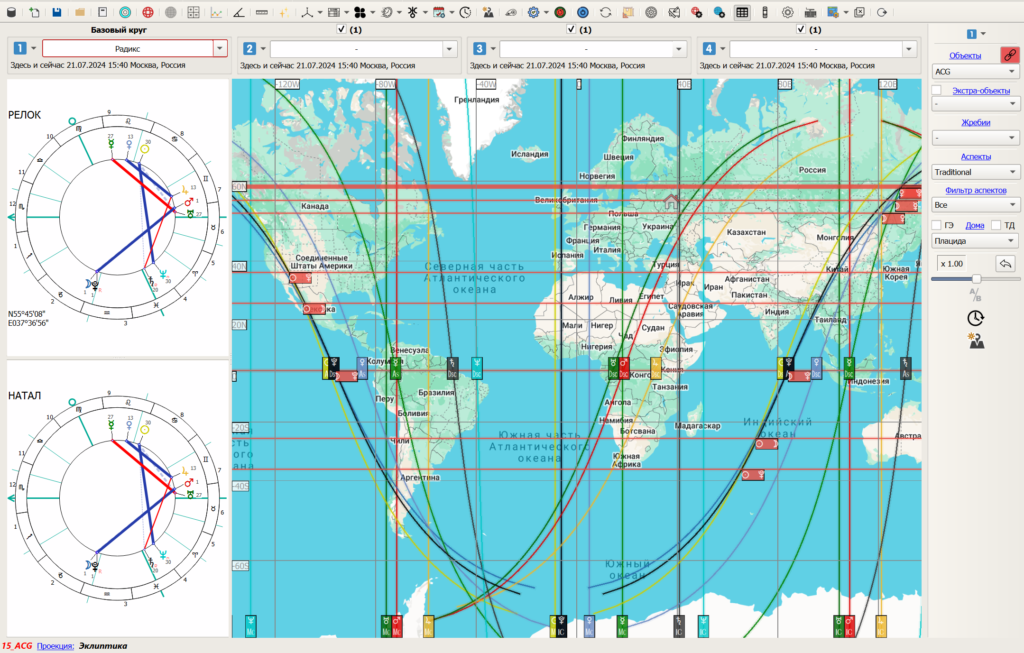
- High-resolution geographical chart, down to houses. Flexible scaling
- Display of aspect lines of planets to angular cusps
- Display of Local Space lines
- Tool for interactive output of arbitrary Local Space lines
- Display of parans, also in tabular form
- Ability to show orb part of aspect lines and parans
- Display of geodetic grid
- Display of Sepharial grid
- Parallel display of astrological charts: natal and relocation
- Quick creation/deletion of user places on the geo-chart
- Relocation, with the possibility to save natal azimuths
- Quick measurement of distance and azimuth between any points on the geo-chart
- Interactive relocation
- Interactive tips
- Highlighting of selected lines
- Cycle chartping. Simultaneous display of natal lines and lines of any other predictive methods (progressions, directions, etc.)
SERVICE FUNCTIONS
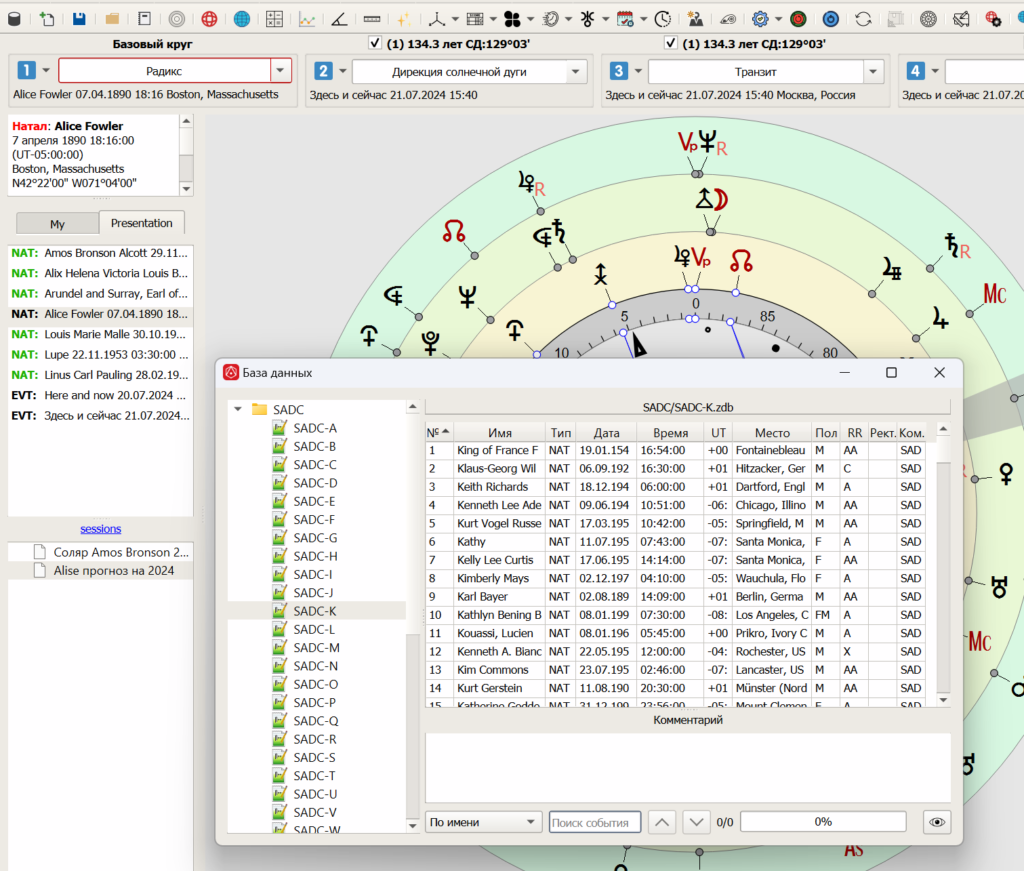
TEMPORAL DATABASE
Contains newly created events or loaded from the main database, as well as those generated during the work with the chart. It has various auxiliary functions for sorting events, calculating some types of charts, quick viewing of events in the form of charts, and quick loading into the selected chart dials.
MAIN DATABASE
Stores events that do not need to be kept handy. In addition to standard options of deletion, cutting, pasting, etc., it has flexible search capabilities for events by various criteria, as well as an analytical block of selected events, in which overall chart indicators are calculated as percentages:
- Objects in signs
- Objects in houses
- Rising sign
- Retrogradation
- Moon phase
Quick search in the selected file by a fragment in the event name or its comment is also organized.
SESSIONS
A session saves your entire current work. A saved session includes information about:
- Current configuration settings
- Events of each dial
- Activity of dials
- Types of charts in each dial
- Number of the current dial
- Direction of aspecting
- Visibility of panels
- Location of open dialog windows (those that can be saved)
DISPLAY OF INTERPRETIVE TEXTS
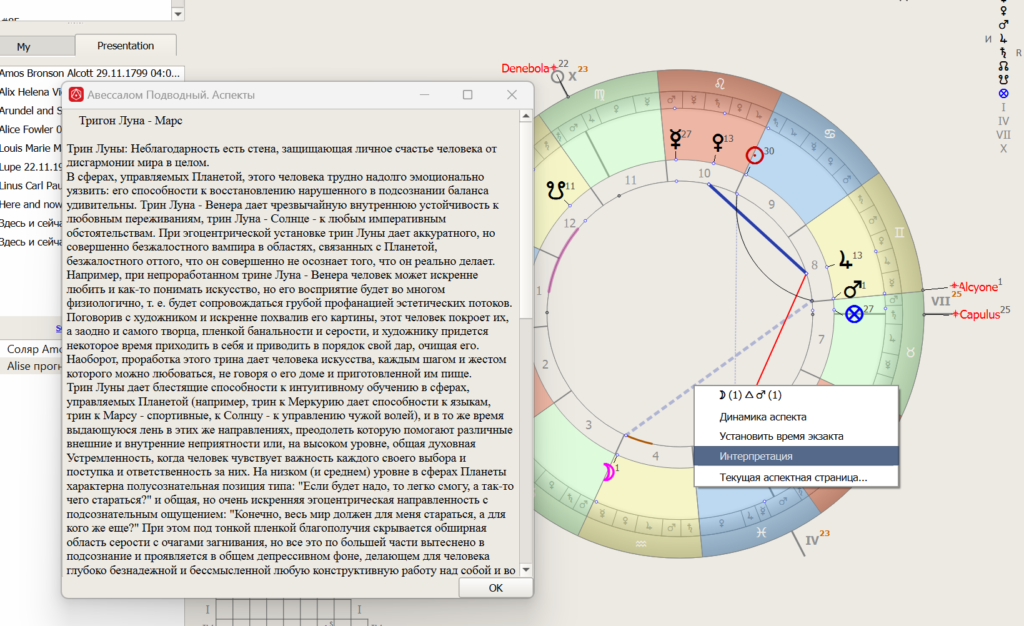
The program can display interpretations for various chart elements, including:
- Stars
- Midpoints
- Sensitive points
- Planets in signs
- Planetary aspects
- Planets in houses
- Lunar mansions
- Nakshatras Users can also create their own texts based on the rules mentioned in the User Manual.
INTERACTIVE TIPS
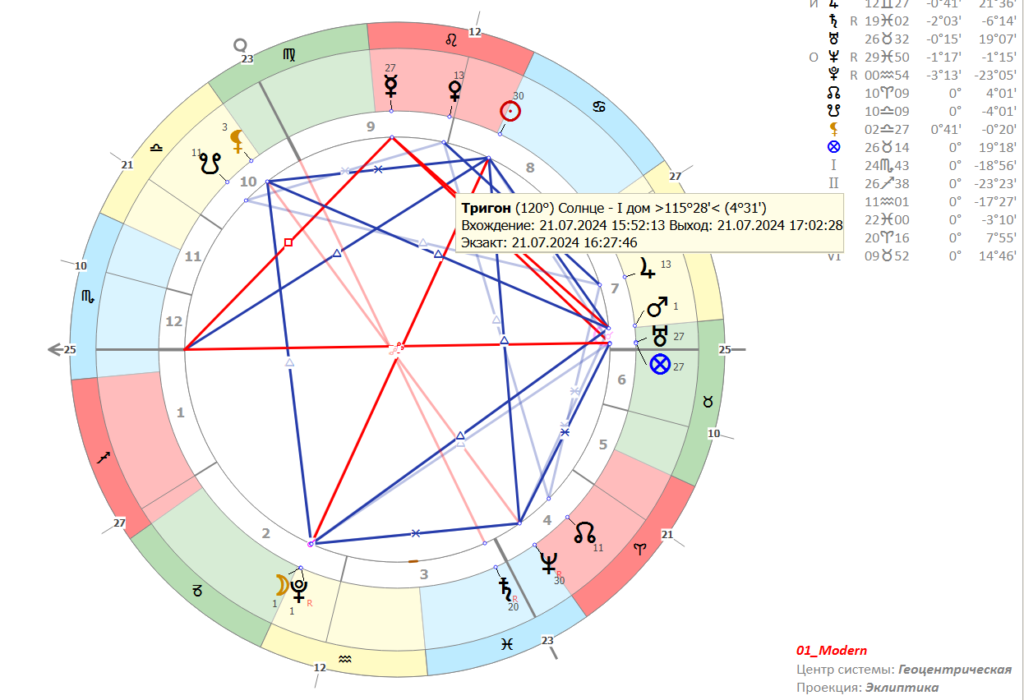
The program has flexible tips for various chart elements, showing selected information. Mainly, it concerns various astronomical or astrological parameters to see them immediately, instead of opening the corresponding calculation tables.